Excerpts from Jim Conrad's
Naturalist Newsletter
from the August 13, 2017 Newsletter issued from Rancho Regenesis in the woods ±4kms west of Ek Balam Ruins; elevation ~40m (~130 ft), N20.876°, W88.170°; north-central Yucatán, MÉXICO
CLIMBING SPINACH
A while back on a visit with Jerry at his Neem farm southwest of Mérida, I was given a couple of small, potted sprouts of what Jerry called Climbing Spinach. I had no idea what it was botanically, but it looked exactly like what Spinach should look like if it were a vine. I planted the slips and now they have produced remarkably fast-growing runners over six feet long (2m), a small portion shown below:
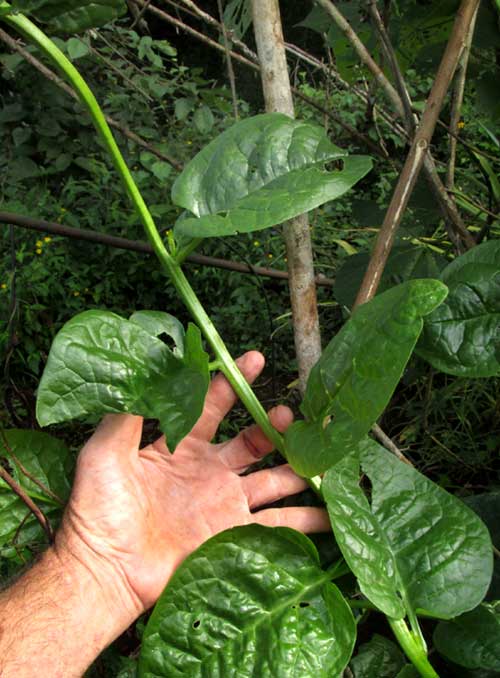
It's unusual to find a garden crop not already planted by the Maya, that can withstand our rainy season's overabundance of diseases and plant-eating insects. Our Climbing Spinach is a little bug-eaten, but at least it's surviving and producing plenty of harvest, which is very noteworthy and encouraging.
But, what is this plant? Its leaves are so Spinach-like that at first I sought it in the Spinach/Amaranth Family, but nothing turned up there. As a last resort I did the very un-botanist thing of searching on the Internet under the key words "climbing spinach," which I'd assumed was just a made-up name, but there it was:
It's BASELLA ALBA, a member of the little-heard-of Basella Family, embracing 19 or so mostly tropical American species. Our Basella alba not only is sometimes known as Climbing Spinach but also as Vine Spinach, Creeping Spinach, Red Vine Spinach, Malabar Spinach, Malabar Nightshade, Buffalo Spinach and Ceylon Spinach. It's native to southeastern Asia and thereabouts, plus it's escaped in various tropical countries.
Its similarity to Spinach is mostly incidental, though on the Phylogenetic Tree of Life the Basella and Amaranth Families reside in the general vicinity of one another. The Basella Family is closer to the Purslane/Portulaca Family, which also produces crisply succulent, often edible leaves.
Actually, in the woods at Chichén Itzá our hut was surrounded by high-twining vines which turned out to be one of the Basella Family's other 18 species. That was Anredera vesicaria, whose page showing a fast-growing, slender vine with leaves somewhat like our Climbing Spinach, appears at www.backyardnature.net/yucatan/anredera.htm
That species is a true vine, but I find that Climbing Spinach would rather scramble about the ground, growing over things, and displays very little tendency to twine about.
I'm experimenting with rooting stem sections of our vine, for this species is worth cultivating on a larger scale. I hope to show results of this effort in a later Newsletter.
from the August 27, 2017 Newsletter issued from Rancho Regenesis in the woods ±4kms west of Ek Balam Ruins; elevation ~40m (~130 ft), N20.876°, W88.170°; north-central Yucatán, MÉXICO
ROOTING CLIMBING SPINACH SPROUTS
On the Internet I've seen that cut sections of Climbing Spinach roots easily if root-grow hormone is used. Here we have no root-grow, so I experimented with placing the bottom ends of stem sections in water. The sections averaged about 15 inches (38cm) in length. Below, you can see my experiment using a discarded Styrofoam cooling container:
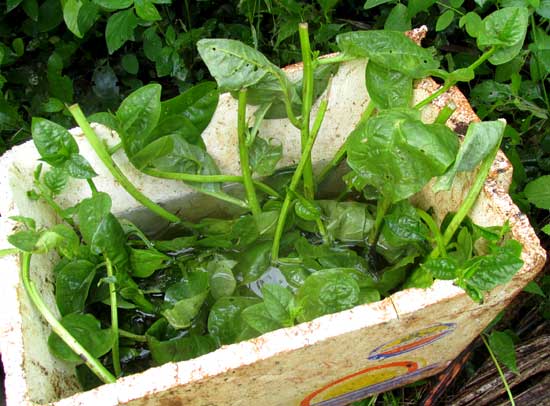
After a week with each stem partly submerged in water, about half of the stems developed rootlets on the submerged parts, as shown below:
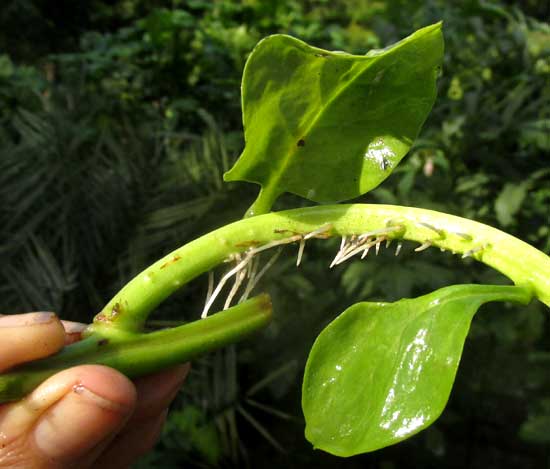
The picture shows one of the most robustly rooting stems; most stems were too weakly rooted to think of potting. I did pot the one in the picture, and five days later the sprout was growing nicely. In the picture, notice that rootlets arise all along the stem, not just at nodes where leaves arise, as is the case with many plants. Also, I found that stem sections cut only at the base but with growing terminal shoots produced more roots than sections cut at both ends.
The mother vine had produced some side sprouts that fell to the ground and rooted. Those rooted sections were cut and transplanted into pots. However, they died and now I believe it was because I'd let the pots receive too much sunlight. This time I've kept the newly potted rooted sections in continual shade and they've all survived. I'll be gradually moving the transplanted sprouts into more sunlight before planting them in their permanent spot.
Our first plants were placed so they could climb a trellis-like affair constructed from tree limbs. However, the plants didn't want to climb at all, despite their common name, so this time I'll be planting them in a flat bed where runners can root wherever they touch the ground, and thus be less vulnerable to water shortages and accidental stem damage.
from the October 1, 2017 Newsletter issued from Rancho Regenesis in the woods ±4kms west of Ek Balam Ruins; elevation ~40m (~130 ft), N20.876°, W88.170°; north-central Yucatán, MÉXICO
CLIMBING SPINACH UPDATE
Below, you can see Climbing Spinach plants rooted about a month ago, not using root-grow hormone:
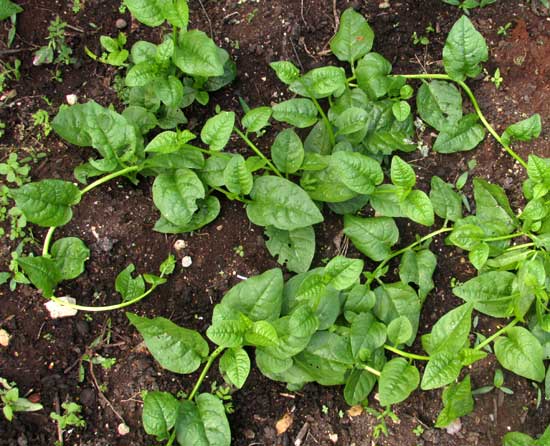
from the November 19, 2017 Newsletter issued from Rancho Regenesis in the woods ±4kms west of Ek Balam Ruins; elevation ~40m (~130 ft), N20.876°, W88.170°; north-central Yucatán, MÉXICO
CLIMBING SPINACH FLOWERING
At first I wondered whether Climbing Spinach would survive here, but now I see that it thrives, growing like a weed. Below, you can see a small part of my crop as of mid November:
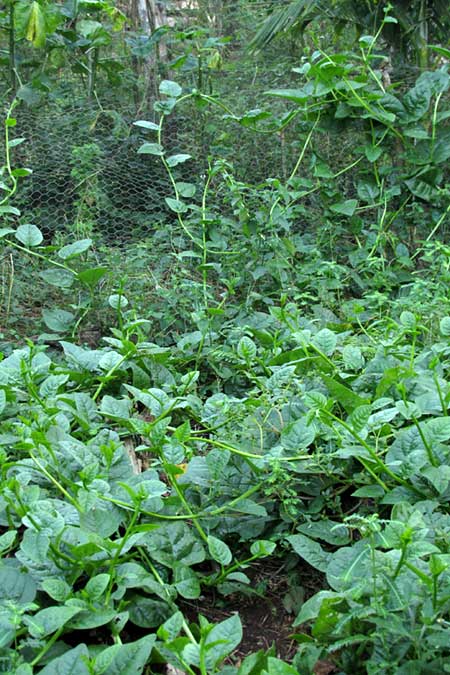
When I first planted it I thought the plant would climb high up a trellis, like vine beans, but they didn't twine and were always taking off across the garden. Then I planted them in beds. Very soon the stems overtook the beds, shot out across open ground to other beds, and even climbed up the chickenwire fence put around the beds to keep out dogs. Happily, I eat their leaves every day and the hotel uses quite a lot, so the rampant growth is OK.
Earlier we noted that Climbing Spinach belongs to the little-heard-of Basella Family. I've been looking forward to seeing the flowers of this unusual family, and now a few plants are hesitantly issuing slender spikes affixed with very small, whitish blossoms, as seen
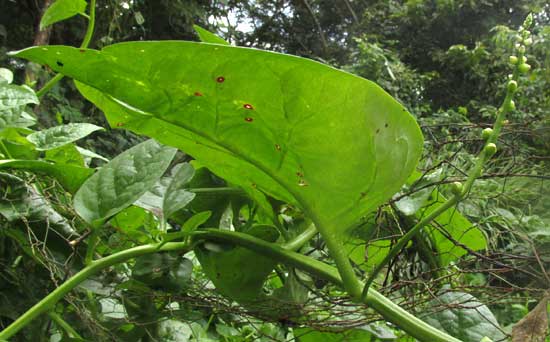
A close-up of some purplish-tipped flowers is shown below:
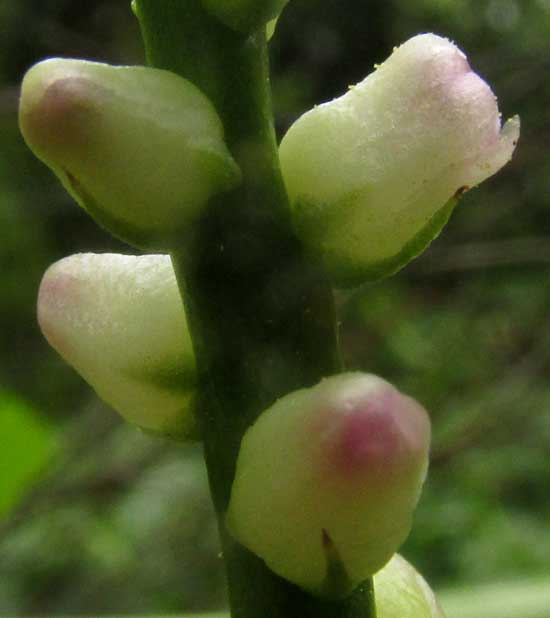
Interesting features of the Basella Family visible in that picture are that the flowers are subtended by two green, sharp-pointed bracts. The green calyx below the urn-shaped corolla consists of only two sepals instead of the usual five, and those may be fused with the corolla. Also, the flowers don't open up more than the one at the top, right in the picture. Cutting across one of the blossoms displays feature seen below:
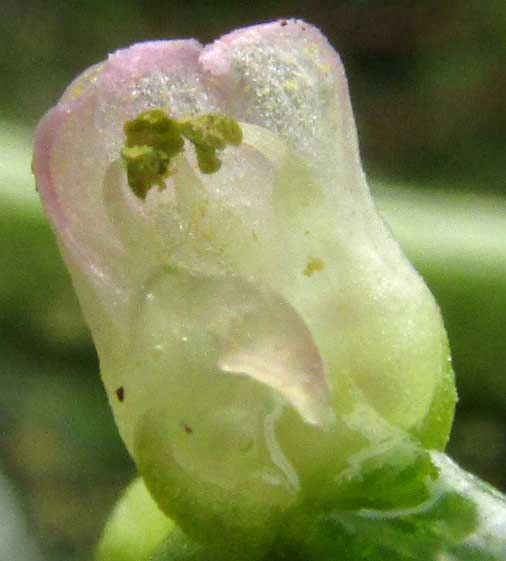
Each flower has five stamens growing from the corolla wall. They're affixed opposite the petals, instead of the usual way of alternating with them.
from the January 28, 2018 Newsletter issued from Rancho Regenesis in the woods ±4kms west of Ek Balam Ruins; elevation ~40m (~130 ft), N20.876°, W88.170°; north-central Yucatán, MÉXICO
CLIMBING SPINACH CLIMBING
Earlier I expressed doubts about the plant being an effective climber. It produces no tendrils and doesn't noticeably wrap around twigs. Now I've seen that Climbing Spinach climbs. Below, you can behold some stems climbing about 15 feet up (4.5m) into branches of a young Ceiba tree:
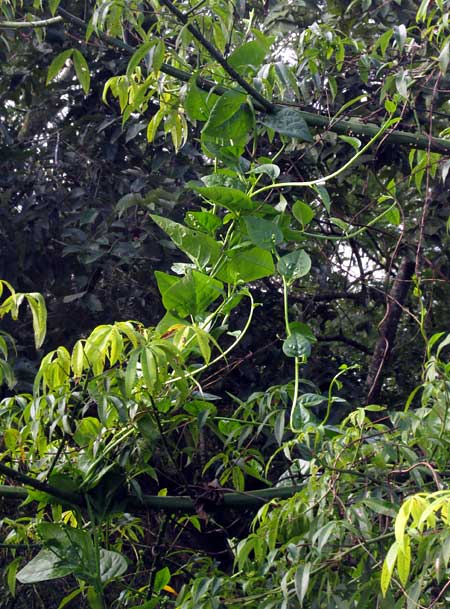
Notice that the stems aren't wrapping themselves around the Ceiba's limbs. They're just wandering among the tree's widely spaced branches, neither following a straight course, nor seeming to make much effort at finding aerial support. Their forward growth is so haphazard that you wonder how they do it. However, the proof is that they're climbing into that Ceiba, and show every indication that they can go quite high if in the mood to do so.
from the November 26, 2017 Newsletter issued from Rancho Regenesis in the woods ±4kms west of Ek Balam Ruins; elevation ~40m (~130 ft), N20.876°, W88.170°; north-central Yucatán, MÉXICO
COMPARING NUTRIENTS OF SPINACH, CLIMBING SPINACH, AND CHAYA
I eat several leaves of Climbing Spinach each morning, in my morning breakfast stews, and carry bags of leaves to the hotel in Ek Balam. The leaves look very much like those of spinach -- despite the two plants belonging to different plant families -- but often I've wondered just how Climbing Spinach's nutritional content compares to that of real spinach. And, for that matter, how both compare to Chaya, the bush leaf used like spinach in many traditional Maya dishes, and which we also grow and eat. You can meet Chaya at www.backyardnature.net/yucatan/malamujr.htm
As a vegetarian, it's important for me to ensure that I get enough protein each day. All three crops turn out to contain about the same percentage of protein, with Chaya possibly having a little more.
Spinach often is sited as being an especially good source for iron. It offers about double the amount of iron as Climbing Spinach, but Chaya contains well over twice the iron as Spinach.
Having such poor vision, I also pay special attention to Vitamin A, which not only prevents night blindness but also protects the body against infections. Spinach contains nearly eight times the Vitamin A of both Climbing Spinach and Chaya.
Often I've heard that folate is important. Climbing Spinach provides only about 60% of the folate as regular spinach, and I don't know how Chaya stacks up for folate.
With this brief, random-sample glance at the comparative nutrient contents of these three crops, my first impression is that Climbing Spinach isn't nearly as nutritious as regular spinach, but Chaya usually more or less holds its own with spinach, though in the case of iron Chaya blows spinach away.